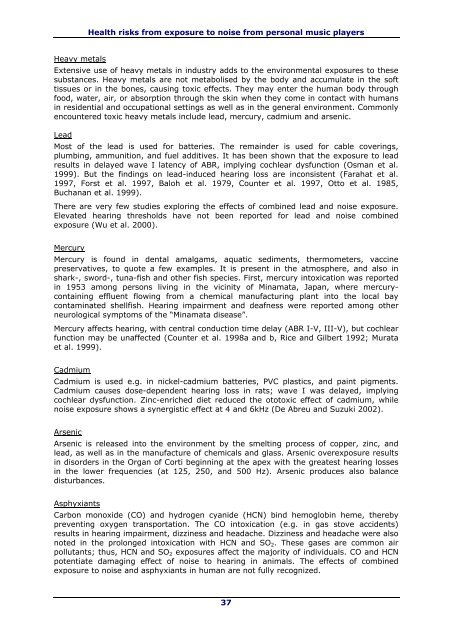Health <strong>risks</strong> <strong>from</strong> <strong>exposure</strong> <strong>to</strong> <strong>noise</strong> <strong>from</strong> <strong>personal</strong> <strong>music</strong> playersconditions occurring at time <strong>of</strong> acoustic trauma or internal conditions linked <strong>to</strong> thegenetics and physiological condition <strong>of</strong> the subject remains unknown. Significantprogresses have been performed recently on these issues.3.5.6.1. Environmental fac<strong>to</strong>rsNoise <strong>exposure</strong>s in combination with several chemical and physical hazards, as well aso<strong>to</strong><strong>to</strong>xic drugs may produce more hearing impairment than could be expected <strong>from</strong><strong>noise</strong>-only <strong>exposure</strong>.ChemicalsChemicals are frequent contaminants in industry, some <strong>of</strong> them might be also common ingeneral environment (heavy metals) or are used in everyday life (paints and lacquers).They are classified in<strong>to</strong> three major groups: organic solvents, heavy metals, andasphyxiants.Almost all studies about association <strong>of</strong> solvent fumes respiration with traumatizing sound<strong>exposure</strong> confirm their clear potentiation <strong>of</strong> NIHL, (Campo et al. 2001, Morata et al.2002, Morata et al. 2003, Sliwinska-Kowalska 2003, Sliwinska-Kowalska et al. 2005, El-Shazly 2006).Organic solventsO<strong>to</strong><strong>to</strong>xic effects <strong>of</strong> organic aromatic solvents, such as <strong>to</strong>luene, styrene, xylene,trichloroethylene, benzene, n-hexane and their mixtures are well recognized. Thesechemicals are frequent air contaminants in industry, such as in paint and lacquerfac<strong>to</strong>ries, dockyards, printing industry, yacht manufacturing, furniture making, plasticsand fibers processing, rubber tires production and many other industrial activities.Exposure may also occur in domestic settings through processed wood products, plasticsfurnishing, paints and lacquers. Animal studies have shown that several organic solvents,as has been exemplified by styrene and <strong>to</strong>luene, damage the cochlea (predominantly thesupporting and outer hair cells) in rats and the <strong>exposure</strong> produces mid-frequency hearingloss (Sliwinska-Kowalska et al. 2007). Alcohol <strong>exposure</strong>, although alone it does notproduce hearing loss, increases significantly the degree <strong>of</strong> hearing impairment caused bystyrene or <strong>to</strong>luene (Campo et al. 1998, Campo et al. 2000). Synergistic effects occur inrats exposed <strong>to</strong> both <strong>noise</strong> and solvents (Campo et al. 2001, Sliwinska-Kowalska et al.2007). It means that hearing impairment is higher than the sum <strong>of</strong> hearing loss producedby solvent <strong>exposure</strong> and <strong>noise</strong> <strong>exposure</strong> alone. In combined <strong>exposure</strong>s, the mostimportant fac<strong>to</strong>r for inducing hearing impairment is potency <strong>of</strong> <strong>noise</strong> <strong>exposure</strong> (level,impulsiveness); concomitant <strong>exposure</strong> <strong>to</strong> organic solvents may induce impairment wherethe <strong>exposure</strong> <strong>to</strong> <strong>noise</strong> alone may have little effect.The o<strong>to</strong><strong>to</strong>xicity <strong>of</strong> organic solvents in occupationally exposed human individuals is moredifficult <strong>to</strong> elucidate. This is because the concentration <strong>of</strong> chemicals is much lower thanthat used in animal studies, and the workers are usually exposed <strong>to</strong> a mixture <strong>of</strong> solventsat widely varying compositions and concentrations, disabling the assessment <strong>of</strong> the effect<strong>of</strong> a single substance (Sliwinska-Kowalska et al. 2001). However, investigations onhumans confirm the findings in animals. It has been shown that organic solvents havedetrimental effects not only on peripheral, but also on central part <strong>of</strong> the audi<strong>to</strong>rypathway (Johnson et al. 2006, Fuente and McPherson B 2007). Thus, pure-<strong>to</strong>neaudiogram might be insufficient <strong>to</strong> moni<strong>to</strong>r this effect, and central audi<strong>to</strong>ry tests must beimplemented. An additive or synergistic effect occurs in case <strong>of</strong> the combined <strong>exposure</strong><strong>to</strong> <strong>noise</strong> and solvents, significantly increasing the odds ratio <strong>of</strong> developing hearing loss(Sliwinska-Kowalska et al. 2003, Sliwinska-Kowalska et al. 2004). The risk for hearingloss increases with the growing number <strong>of</strong> solvents in a mixture.36
Health <strong>risks</strong> <strong>from</strong> <strong>exposure</strong> <strong>to</strong> <strong>noise</strong> <strong>from</strong> <strong>personal</strong> <strong>music</strong> playersHeavy metalsExtensive use <strong>of</strong> heavy metals in industry adds <strong>to</strong> the environmental <strong>exposure</strong>s <strong>to</strong> thesesubstances. Heavy metals are not metabolised by the body and accumulate in the s<strong>of</strong>ttissues or in the bones, causing <strong>to</strong>xic effects. They may enter the human body throughfood, water, air, or absorption through the skin when they come in contact with humansin residential and occupational settings as well as in the general environment. Commonlyencountered <strong>to</strong>xic heavy metals include lead, mercury, cadmium and arsenic.LeadMost <strong>of</strong> the lead is used for batteries. The remainder is used for cable coverings,plumbing, ammunition, and fuel additives. It has been shown that the <strong>exposure</strong> <strong>to</strong> leadresults in delayed wave I latency <strong>of</strong> ABR, implying cochlear dysfunction (Osman et al.1999). But the findings on lead-induced hearing loss are inconsistent (Farahat et al.1997, Forst et al. 1997, Baloh et al. 1979, Counter et al. 1997, Ot<strong>to</strong> et al. 1985,Buchanan et al. 1999).There are very few studies exploring the effects <strong>of</strong> combined lead and <strong>noise</strong> <strong>exposure</strong>.Elevated hearing thresholds have not been reported for lead and <strong>noise</strong> combined<strong>exposure</strong> (Wu et al. 2000).MercuryMercury is found in dental amalgams, aquatic sediments, thermometers, vaccinepreservatives, <strong>to</strong> quote a few examples. It is present in the atmosphere, and also inshark-, sword-, tuna-fish and other fish species. First, mercury in<strong>to</strong>xication was reportedin 1953 among persons living in the vicinity <strong>of</strong> Minamata, Japan, where mercurycontainingeffluent flowing <strong>from</strong> a chemical manufacturing plant in<strong>to</strong> the local baycontaminated shellfish. Hearing impairment and deafness were reported among otherneurological symp<strong>to</strong>ms <strong>of</strong> the “Minamata disease”.Mercury affects hearing, with central conduction time delay (ABR I-V, III-V), but cochlearfunction may be unaffected (Counter et al. 1998a and b, Rice and Gilbert 1992; Murataet al. 1999).CadmiumCadmium is used e.g. in nickel-cadmium batteries, PVC plastics, and paint pigments.Cadmium causes dose-dependent hearing loss in rats; wave I was delayed, implyingcochlear dysfunction. Zinc-enriched diet reduced the o<strong>to</strong><strong>to</strong>xic effect <strong>of</strong> cadmium, while<strong>noise</strong> <strong>exposure</strong> shows a synergistic effect at 4 and 6kHz (De Abreu and Suzuki 2002).ArsenicArsenic is released in<strong>to</strong> the environment by the smelting process <strong>of</strong> copper, zinc, andlead, as well as in the manufacture <strong>of</strong> chemicals and glass. Arsenic over<strong>exposure</strong> resultsin disorders in the Organ <strong>of</strong> Corti beginning at the apex with the greatest hearing lossesin the lower frequencies (at 125, 250, and 500 Hz). Arsenic produces also balancedisturbances.AsphyxiantsCarbon monoxide (CO) and hydrogen cyanide (HCN) bind hemoglobin heme, therebypreventing oxygen transportation. The CO in<strong>to</strong>xication (e.g. in gas s<strong>to</strong>ve accidents)results in hearing impairment, dizziness and headache. Dizziness and headache were alsonoted in the prolonged in<strong>to</strong>xication with HCN and SO 2 . These gases are common airpollutants; thus, HCN and SO 2 <strong>exposure</strong>s affect the majority <strong>of</strong> individuals. CO and HCNpotentiate damaging effect <strong>of</strong> <strong>noise</strong> <strong>to</strong> hearing in animals. The effects <strong>of</strong> combined<strong>exposure</strong> <strong>to</strong> <strong>noise</strong> and asphyxiants in human are not fully recognized.37
















